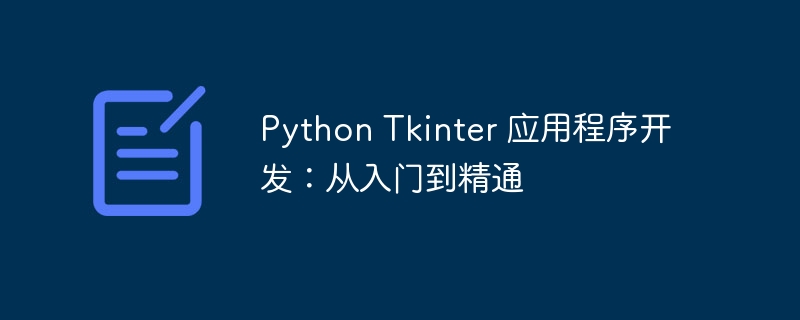Home >Backend Development >Python Tutorial >Python Tkinter Application Development: From Beginner to Mastery
Python Tkinter Application Development: From Beginner to Mastery
- PHPzforward
- 2024-03-24 09:30:121216browse

Tkinter is a standard GUI library for python used to create cross-platform desktop applications. It provides a simple interface that enables developers to easily create applications with basic controls such as windows, buttons, labels, etc.
2. Install TkinterBy default, Tkinter is included in the
Python installation package. If needed, you can install it using the following command:
pip install tkinter
import tkinter as tk
# 创建 Tkinter 应用程序的根窗口
root = tk.Tk()
# 设置窗口标题
root.title("我的第一个 Tkinter 应用程序")
# 设置窗口大小
root.geometry("400x300")
# 进入 Tkinter 应用程序的主事件循环
root.mainloop()
- Buttons:
- Create buttons to perform actions. Tag:
- Display uneditable text. Text box:
- Allows the user to enter text. Checkbox:
- Allows the user to select one of multiple options. Radio button:
- Allows the user to select one from a set of options.
# 创建一个按钮 button = tk.Button(root, text="点击我") button.pack() # 创建一个标签 label = tk.Label(root, text="你好,世界!") label.pack() # 创建一个文本框 entry = tk.Entry(root) entry.pack()
Event handling allows applications to respond when the user interacts with a control. Tkinter provides the
bind() method to bind events to controls.
<pre class="brush:python;toolbar:false;"># 当用户点击按钮时,打印 "按钮被点击了!"
button.bind("<Button-1>", lambda e: print("按钮被点击了!"))</pre>
Layout management determines the position and size of controls in the window. Tkinter provides a variety of layout managers, including
pack(), grid() and place().
- pack():
- Automatically arrange controls according to their natural size. grid():
- Arrange controls in a grid, allowing more precise position control. place():
- Allows developers to manually set the position and size of controls.
Tkinter allows developers to create menus and menu items to provide additional functionality.
# 创建一个菜单栏 menubar = tk.Menu(root) # 创建一个文件菜单 filemenu = tk.Menu(menubar, tearoff=0) filemenu.add_command(label="新建") filemenu.add_command(label="打开") filemenu.add_separator() filemenu.add_command(label="退出", command=root.quit) # 将文件菜单添加到菜单栏 menubar.add_cascade(label="文件", menu=filemenu) # 将菜单栏添加到根窗口 root.config(menu=menubar)8. Window management
Tkinter provides several methods to manage windows:
- show()
- : Display window.
- : Hide the window.
- : Force the contents of the window to be updated.
- : Destroy the window.
- Adaptive window:
- Window can automatically resize based on window content or screen resolution. Custom themes:
- Developers can create custom themes to modify the appearance of the application. Event-driven programming:
- Tkinter uses an event-driven model, allowing applications to respond to user input and other events. Threads:
- Tkinter applications can achieve concurrency by using threads. Database Integration:
- Tkinter applications can connect to databases and perform queries and updates.
The above is the detailed content of Python Tkinter Application Development: From Beginner to Mastery. For more information, please follow other related articles on the PHP Chinese website!

